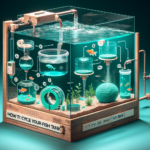If placed correctly, an aquarium heater will help to maintain stable water temperatures throughout your fish tank. This is important, as inconsistant or uneven water temperature can stress fish and other inhabitants, potentially leading to larger issues down the line. This guide is designed to give you some practical tips around optimal fish tank heater placement.
Understanding Aquarium Heaters
Aquarium heaters are an essential component of a tropical fish tank. There are various types of aquarium heaters available, including submersible heaters, external heaters, and inline heaters. Submersible heaters are the most common type and are designed to be fully submerged in your tank water. They are usually equipped with a thermostat that regulates the temperature and a heating element that warms the water. The thermostat works to automatrically keep the water at a consistent temperature, saving you the job of needing to monitor the temperature and turn the heater on and off yourself. As most tropical fish keepers will use a submersible heater in their tank, we will focus on those for this article.

Why Proper Placement of Your Aquarium Heater Matters
The location of your aquarium heater significantly affects its efficiency at doing its job. A well-placed heater facilitates a uniform temperature distribution, preventing hot or cold spots that can stress or harm your fish. Most aquarium inhabitants are sensitive to fluctuations in water temperature, which can weaken their immune systems and make them more susceptible to diseases. An even heat distribution will also help to minimise pockets of warmer water, which contain lower levels of dissolved oxygen and, if extreme, can negatively impact the health of your fish.
Key Factors to Consider When Placing Your Aquarium Heater
Before installing your heater, consider the following factors:
Tank Size: If you have a larger tank, you might consider using multiple smaller heaters instead of one larger heater. Placed at either ends of the tank, this can help to maintain a more consistent temperature. This doesn’t need to cost extra energy, just divide the heating requirement in half e.g., 2x 200W rather than 1x 400W. An added benefit of this approach is that you now also have a backup heater in the aquarium in case the other heater fails, helping to minimise any drop in water temperature before you can get the other replaced.
Water Flow: Position the heater near areas of high water flow, such as the filter outlet or near a powerhead, to promote even heat distribution using the tank’s natural water circulation. Placing the heater by the filter outlet helps to quickly circulate warm water throughout the tank.
Heater Orientation: Submersible heaters can be placed any angle from horizontally to vertically. The main goal with your choice of angle is to maximise even heat distribution. For example, you might run it horizontally across the bottom of the back wall of your tank. Or, you might consider to place it vertically in front of the outflow value of your filter so more water runs across it. My preference is to place the heater on a 45deg angle, getting the best of both worlds. Make sure you choose the angle that will work best for your tank shape and size. Just remember to make sure that the whole of the heater tube is placed fully under the water line and not touching other items – such as the substrate or decorations. Otherwise the heater can get damaged, or worse, the thermistor can get confused an overheat the water. Ensure you follow the manufacturer’s guidelines for your specific heater type.
Step-by-Step on How to Install Your Submersible Aquarium Heater
Here’s a guide on how to install a water heater in a fish tank:
Choose the Right Heater Type: As mentioned above, there are different types of aquarium heaters, including submersible heaters (which can be placed underwater horizontally or vertically) and immersible heaters (which are partially submerged). For the majority of users, a submersible heater is all you need. Select the style and wattage (heating capacity) based on your tank’s size and requirements.
Read the Manufacturer’s Instructions: Safety first! Each heater has specific installation guidelines. Review the instructions carefully to understand any specific recommendations or warnings from the manufacturer.
Consider installing a heater guard: This step is optional, and will be dependent on the type of inhabitants you keep in your aquarium. If you have fish that like to stick to flat surfaces, eg plecos, or others that have a tendency to get stuck in small places, a heater guard might be worth considering. These slot over the heating tube and create a more insulated surface so that any fish likely to get too close to the heater don’t get burnt.
Turn Off Electrical Devices: Another safety step here. It’s best to turn off all electrical equipment connected to your tank, such as filters, lights, and other devices, before installing the heater. This minimises the risk of electric shock or equipment damaned, in the event that any water gets spilled onto electrical items during the install.
Position the Heater in the Tank: As discussed above, the aim is for even heat distribution here. So to recap, place the heater fully under the water, at any angle between horizontal and vertical, and in an area of higher water movement. Alternatively, if your setup uses a sump, you might choose to place your heater inside the sump instead. This keeps the fishtank looking clean of equipment and will still assist with the even distribution of warm water throughout the aquarium.
Secure the Heater with Suction Cups or Brackets: Attach the heater to the tank (or sump) wall using the suction cups or brackets provided. Make sure it’s firmly in place and won’t shift if the fish swim by, if the filter creates a strong current, or if you accidently knock it while cleaning the tank.
Allow the Heater to Adjust Gradually: Before turning on the heater, allow it to sit in the tank for about 20-30 minutes. This helps the heater adjust to the water temperature and reduces the risk of cracking from sudden temperature changes (noting most heating elements are surrounded by a glass tube).
Set the Desired Temperature: Use the thermostat on the heater to set your tank’s desired temperature. Most tropical fish need a range of 23–26°C / 74–78°F, but research your specific fish species to confirm what will be best for them.
Turn On the Heater and Monitor: After the adjustment period, turn on your heater. Use a thermometer to check the water temperature and ensure it that the heater is working properly. For larger tanks, it may take several hours for the heater to reach the desired temperature range and for the water to stablize throughout the tank. Note: It’s common for there to be a slight discrepancy between the value on the thermostat and the final heated water (due to heat excahange with the surrounding environment), so do keep an eye on this as you are setting up. Check the water temperature at various locations in the tank to confirm you chose a good placement for the heater, and that there are no areas of cooler water.
Regularly Check the Temperature: Monitor the water temperature, especially in the first few days, to ensure that your heater is functioning properly. Adjust the heater if necessary.

Heater Protection and Safety
Highlighting a few of these points here for you skim readers. Treat your heater with respect, to prevent causing any damage to it, your fish and yourself. Always follow the manufacturer’s instructions for the specific heater model, and take precautions to prevent electrical shock. Make sure the glass tube of the heater is not directly touching any of the aquarium glass, substrate, and decorations to prevent cracking or hot spots. Also, avoid placing powerboards and electrical cables under the tank to prevent electrical shock hazards. Consider hanging powerboards on the wall for added safety, and always add a drip loop.
Some Final Tips and Reminders Regarding Aquarium Heaters
Buy a quality heater: As an item in your tank that is always running, and, in some cases, vital to be working well to keep your fish alive, save yourself the headache and buy a decent heater. Consider using a quality heater with a built-in thermostat and a durable heating element to ensure reliable performance. It doesn’t need to cost a lot, but go for a trusted brand and they should last you a very long time. I’ve always had good experience with the AquaOne Heater range, though there are many other good brands out there too.
If in doubt, go up a size: If unsure of heater capacity, or are on a borderline between 2 options, consider going for the larger option. Providing your heater has a thermostat built in, it won’t overheat your tank. If anything it will just heat up a bit faster But if underpowered, you might stress the heating element and shorten its lifespan.
Use Multiple Heaters for Large Tanks: In larger aquariums, using two heaters at opposite ends can provide more consistent temperatures and serve as a backup if one fails.
Regular Maintenance: Periodically check your heater for signs of wear or malfunction, and clean it as needed to keep it in a good working condition.
Safety Precautions: Always unplug the heater before performing any maintenance or water changes in your tank. And, when turned on, keep the heater fully submersed and not touching other tank structure.




